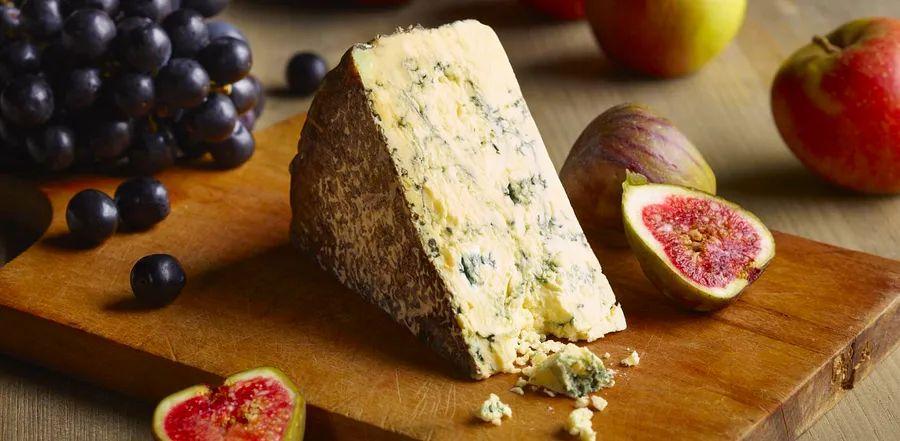Is Blue Cheese Just Mold in Disguise?

Cheese lovers know the cheese board is filled with a wide range of textures and colors. But one variety often steals the spotlight among a selection of crackers, baguettes, spreads, and cured meats — blue cheese.
The striking appearance of blue cheese, with its vibrant veins of color, makes it easily recognizable. For many, it’s an acquired taste, so let's explore what makes this dairy favorite so distinct.
What Gives Blue Cheese Its Color?
Blue cheese refers to a group of cheeses made from cow, goat, or sheep's milk, all of which are introduced to the blue mold spores Penicillium.
After removing the whey from the cheese mixture, cheesemakers form the curds into wheels. At this stage, they introduce the Penicillium mold and puncture the cheese with steel needles, allowing oxygen to penetrate and encourage the growth of the characteristic blue veins. Salt is added to preserve the cheese and prevent spoilage.
The cheese wheel is then aged in a cool, dark, and humid environment. Depending on the type of blue cheese, this curing process can take anywhere from several weeks to months.
So, Is Blue Cheese Safe to Consume?
Blue cheese is completely safe to eat, as the digestive process breaks down the active spores. However, if you're lactose intolerant or allergic to milk proteins, it's best to avoid blue cheese since it contains dairy.
Different Varieties of Blue Cheese
Each variety of blue cheese brings its own unique look, texture, and a deliciously distinctive flavor and aroma.
These variations stem from the cheesemaking method, the specific strain of Penicillium used, the aging process, and how the mold spreads, creating the characteristic marbling pattern.

Dotdash Meredith Food Studios
Discover the recipe: Wedge Salad with Blue Cheese Dressing
French Roquefort
This is the earliest known blue cheese, with the Penicillium roqueforti mold first discovered in the caves of Roquefort-sur-Soulzon, France.
Roquefort is made from sheep's milk and aged for up to 9 months. This semi-hard cheese has a moist, creamy texture that crumbles easily, offering a rich blend of sharp, tangy, savory, and salty flavors, with a bitter edge from the mold and a subtle sweetness from the milk.
Roquefort can be enjoyed on its own, crumbled over salads, pizzas, and steaks, or used in dips, sauces, and dressings.
Gorgonzola
Gorgonzola is a type of blue cheese made from cow's milk, originating from northern Italy. The cheese is crafted by blending cow's milk with Penicillium mold and aged for 30 to 60 days.
The texture of Gorgonzola can vary from semi-soft and crumbly to soft and creamy, depending on the length of the aging process.
It makes a great melting cheese for dishes like toast, pasta, and risotto, or can be spread on sandwiches and used to create dips and sauces.
Danish Blue Cheese
Danish blue cheese is a milder option, perfect for blue cheese beginners. A semi-soft cheese, it has a shorter aging period of 8 to 12 weeks, resulting in a less intense spicy and salty flavor compared to other varieties.
This blue cheese complements meat-based dishes like steak and enhances the flavor of pasta, stews, and soups.
English Blue Stilton
Stilton is a pale, semi-soft cheese with a crumbly texture, offering a sharp combination of tanginess, spice, earthiness, and savory notes. It takes at least nine weeks to create.
Stilton pairs beautifully with pears, walnuts, salads, dressings, dips, sauces, and soups. However, nothing compares to the classic pairing of Stilton with a glass of sweet sherry. The creamy fat of the cheese coats the palate, while the wine’s richness adds depth, creating a delightful culinary experience.
Maytag Blue Cheese
Maytag Blue cheese has a bold, nutty, earthy, and tangy flavor. Produced locally in Iowa from cow's milk, it is slightly crumbly but still soft enough to be used as a creamy topping for salads and pizzas.
How to Use Blue Cheese
The crumbly varieties of blue cheese add a burst of flavor to dishes like our Roquefort Pear Salad or appetizers such as Bacon-Wrapped Dates with Blue Cheese. They are also perfect for making cheese butter to accompany main dishes, as well as for cheese sauces, fondue, or butter.
Crumbly blue cheese also enhances dishes like stuffed meatballs, burger patties, and roasted portobello mushrooms, elevating their umami and saltiness.
Blue cheeses with a softer, creamier texture are perfect for creating savory cheesecakes, dressings, dips, and gravies that pair wonderfully with meats.
Evaluation :
5/5



